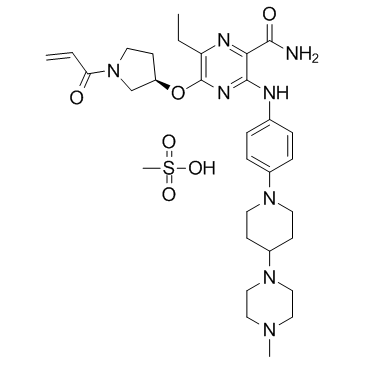Naquotinib mesylate (ASP8273) (Synonyms: ASP8273 (mesylate)) |
| Catalog No.GC32836 |
Naquotinib mesylate (ASP8273) (ASP8273 mesylate) is an orally available, mutant-selective and irreversible EGFR inhibitor; with IC50s of 8-33 nM toward EGFR mutants and 230 nM for EGFR.
Products are for research use only. Not for human use. We do not sell to patients.

Cas No.: 1448237-05-5
Sample solution is provided at 25 µL, 10mM.
Naquotinib mesylate (ASP8273) is an orally available, mutant-selective and irreversible EGFR inhibitor; with IC50s of 8-33 nM toward EGFR mutants and 230 nM for EGFR.
In assays using endogenously EGFR-dependent cells, Naquotinib inhibits the growth of PC-9(del ex19), HCC827(del ex19), NCI-H1975(del ex19/T790M) and PC-9ER(del ex19/T790M) with IC50s of 8-33 nM[1]. Naquotinib selectively inhibits phosphorylation of EGFR and its down-stream signal pathway, ERK and Akt from 10nM in HCC827 and NCI-H1975 while inhibitory effects are only detected at 1000nM in A431.In NCI-H1650 (del ex19), Naquotinib inhibits cell growth with an IC50 value of 70nM while other EGFR-TKIs are only partially effective[2].
Oral Naquotinib treatment dose dependently induces tumor regression in NCI-H1975 (L858R/T790M), HCC827 (del ex19) and PC-9 (del ex19) xenograft models. Dosing schedules does not affect the efficacy of Naquotinib. In an NCI-H1975 xenograft model, complete regression of tumor is achieved after 14-days of Naquotinib treatment. Complete regression is maintained in 50% of mice more than 85 days after cessation of Naquotinib treatment[2].
[1]. Sakagami H, et al. ASP8273, a novel mutant-selective irreversible EGFR inhibitor, inhibits growth of non-small cell lung cancer (NSCLC) cells with EGFR activating and T790M resistance mutations. [abstract]. In: Proceedings of the 105th Annual Meeting of the American Association for Cancer Research; 2014 Apr 5-9; San Diego, CA. Philadelphia (PA): AACR; Cancer Res 2014;74(19 Suppl):Abstract nr 1728. doi:10.1158/1538-7445.AM2014-1728 [2]. Konagai S, et al. ASP8273 selectively inhibits mutant EGFR signal pathway and induces tumor shrinkage in EGFR mutated tumor models. [abstract]. In: Proceedings of the 106th Annual Meeting of the American Association for Cancer Research; 2015 Apr 18-22; Philadelphia, PA. Philadelphia (PA): AACR; Cancer Res 2015;75(15 Suppl):Abstract nr 2586. doi:10.1158/1538-7445.AM2015-2586
| Cas No. | 1448237-05-5 | SDF | |
| Synonyms | ASP8273 (mesylate) | ||
| Canonical SMILES | O=C(C1=NC(CC)=C(O[C@H]2CN(C(C=C)=O)CC2)N=C1NC3=CC=C(N4CCC(N5CCN(C)CC5)CC4)C=C3)N.CS(=O)(O)=O | ||
| Formula | C31H46N8O6S | M.Wt | 658.81 |
| Solubility | DMSO : 12.5 mg/mL (18.97 mM) | Storage | Store at -20°C |
| General tips | Please select the appropriate solvent to prepare the stock solution according to the
solubility of the product in different solvents; once the solution is prepared, please store it in
separate packages to avoid product failure caused by repeated freezing and thawing.Storage method
and period of the stock solution: When stored at -80°C, please use it within 6 months; when stored
at -20°C, please use it within 1 month. To increase solubility, heat the tube to 37°C and then oscillate in an ultrasonic bath for some time. |
||
| Shipping Condition | Evaluation sample solution: shipped with blue ice. All other sizes available: with RT, or with Blue Ice upon request. | ||
| Prepare stock solution | |||

|
1 mg | 5 mg | 10 mg |
| 1 mM | 1.5179 mL | 7.5894 mL | 15.1789 mL |
| 5 mM | 0.3036 mL | 1.5179 mL | 3.0358 mL |
| 10 mM | 0.1518 mL | 0.7589 mL | 1.5179 mL |
Step 1: Enter information below (Recommended: An additional animal making an allowance for loss during the experiment)
 g
g
 μL
μL

Step 2: Enter the in vivo formulation (This is only the calculator, not formulation. Please contact us first if there is no in vivo formulation at the solubility Section.)
Calculation results:
Working concentration: mg/ml;
Method for preparing DMSO master liquid: mg drug pre-dissolved in μL DMSO ( Master liquid concentration mg/mL, Please contact us first if the concentration exceeds the DMSO solubility of the batch of drug. )
Method for preparing in vivo formulation: Take μL DMSO master liquid, next addμL PEG300, mix and clarify, next addμL Tween 80, mix and clarify, next add μL ddH2O, mix and clarify.
Method for preparing in vivo formulation: Take μL DMSO master liquid, next add μL Corn oil, mix and clarify.
Note: 1. Please make sure the liquid is clear before adding the next solvent.
2. Be sure to add the solvent(s) in order. You must ensure that the solution obtained, in the previous addition, is a clear solution before proceeding to add the next solvent. Physical methods such as vortex, ultrasound or hot water bath can be used to aid dissolving.
3. All of the above co-solvents are available for purchase on the GlpBio website.
Quality Control & SDS
- View current batch:
- Purity: >98.00%
- COA (Certificate Of Analysis)
- SDS (Safety Data Sheet)
- Datasheet
Average Rating: 5 (Based on Reviews and 39 reference(s) in Google Scholar.)
GLPBIO products are for RESEARCH USE ONLY. Please make sure your review or question is research based.
Required fields are marked with *



















